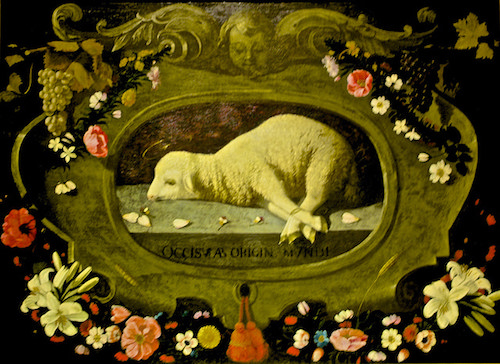We run our website the way we wished the whole internet worked: we provide high quality original content with no ads. We are funded solely by your direct support. Please consider supporting this project.

Christus Victor Atonement and Girard’s Scapegoat Theory
Many of the major criticisms of Crucifixion of the Warrior God that have been raised since it was published four weeks ago have come from folks who advocate Rene Girard’s understanding of the atonement. A major place where these matters are being discussed is here, and you are free to join.
Now, I have to say that it honestly seems to me that most of these criticisms are based on a misreading of my work (more below). But I also want to say that I’m truly thankful for them, for they have forced me to think through the relationship between my Christus Victor understanding of the atonement and the scapegoating understanding of Girard.[1]
So I thought it might help to clarify some misunderstandings of my view if I shared my reflections on this relationship in a post. In the process of sharing these reflections I will respond to several of the major criticisms the Girardians have raised against my view, and discuss why I think they’re based on a misreading of my work.
***
Atonement theories have customarily been grouped into two camps: a) subjective atonement theories, where the cross is understood to change something in us, but not fundamentally affect the way things are, and; b) objective atonement theories, where the cross is understood to fundamentally affect the way things are and only affect a change in us as a consequence of this.
If I understand him correctly, Girard advocates a subjective atonement theory. The cross exposes the lie of our scapegoat mechanism and thus opens up a non-violent way for us to deal with conflict. The cross also reveals God’s true non-violent nature by exposing all our violent conceptions of God to be projections. It’s worth noting that a number of my critics hold up this view as a more plausible way of understanding the cross and of interpreting the Old Testament’s (OT) violent divine portraits of God than what I advocate in CWG. I thus have a vested interest in arguing that this view is inadequate and that these critics are mistaken.
To be sure, I wholeheartedly agree that Girard’s understanding of the cross is good, so far as it goes. As I flesh it out in CWG, Girard is getting at one of the fundamental reasons why God had to stoop to take on the appearance of a perpetrator of violence in the biblical narrative leading up to the cross, but had to stoop to take on the appearance of a God-forsaken victim of violence in the historical crucifixion.
Having granted this much, however, I don’t believe Girard’s view goes far enough, at least not if our goal is to make sense of what the New Testament (NT) says was accomplished on the cross.
***
As the NT depicts it, the problem that God was addressing on the cross goes beyond our scapegoating mechanism. The NT rather teaches that there is something fundamentally wrong with the way things are. We have an objective problem that calls for an objective solution.
Because of a rebellion in our primordial past combined with our own sin, we are in bondage to “the power of Satan” and “the kingdom of darkness” (Acts 26:17-18; Col 1:13). The entire world system is under the corrupting influence of the powers (Lk 4:6-7), which is why Satan is called “the god of this age” (2 Cor 4:4) the “ruler of the world” (Jn 12:31; 14:30; 16:11) and the one who “controls the entire world” (I Jn 5:19). Because of this bondage, our hearts and wills are fundamentally corrupt, to the point that we are “slaves” who are “dead in sin” (Jn 8:34; Eph 2:1,5) and who are spiritually blind (2 Cor 4:4). In this state, we are fundamentally estranged from God and destined for destruction, which is why the author of Ephesians says we were “enemies” and “by nature children of wrath” (Rom 5:10; Eph 2:3).
This is what God needed to solve through Jesus’ cross-centered life and ministry. Note, in my view, the problem was not that God needed to vent his wrath on Jesus so he wouldn’t have to vent it on us. I agree with Tom Wright (The Day the Revolution Began) that this view of the atonement is completely pagan. As I argue at length in CWG, God’s “wrath” isn’t an emotion in God: it’s simply God’s reluctant decision to let people experience the destructive consequences that are intrinsic to their sin when he sees his merciful protection is enabling them. When Jesus drank from “the cup” of God’s wrath (Matt 26:39, 42; cf. Isa 51:17, 22; Jer 25:15), he was simply embracing the plan to suffer the death consequences of sin that we deserved.
And when I say “that we deserved,” you must not think of this in judicial terms, as though God needs to avenge wrongdoing. We “deserved” these consequences only in the sense that these consequences are intrinsic to our own sinful decisions. When we reject the God who is life itself, we are choosing death in the process.
In my view, the cross represents Jesus entering into our self-made death-domain as our representative head (on the importance of this concept in Jewish thought and in the NT, see Wright, The Day the Revolution Began). In accordance with the plan that the Father, Son and Spirit had previously agreed to, the Father “delivered Jesus over” to wicked humans operating under the influence of wicked powers (Rom 4:25; 8:32). And on the cross, Jesus entered into complete solidarity with our fallen humanity, our bondage to the powers and to sin, our corrupted nature, our spiritual blindness, our shame, guilt and condemnation, our scapegoat mechanism, and the self-inflicted estrangement from God that accompanies all these things.
In solidarity with our sin and estrangement from God, and experiencing this from the inside, Jesus cries out, “My God, my God, why have you forsaken me?” The Father had indeed delivered Jesus over to people whom he knew would turn him into their scapegoat, but the Father had not forsaken Jesus, for this plan was agreed upon all three Persons of the Trinity from the start. Yet, in the physical and mental agony of the moment, Jesus was delirious – somewhat like a delirious woman in labor might blame her pain on her husband, forgetting for a moment that she had nine-months earlier agreed to the plan. Jesus’ cry can be understood to be a testament to the authenticity of his solidarity with us in our God-alienated state.
***
Some have alleged that this view disrupts the love that defines God’s triune essence, and this entails that the Trinity had temporarily dissolved. While some theologians come close to speaking this way, I think it is as unintelligible as it is unnecessary. It’s unintelligible because God’s triune essence can’t be conceived of as a contingency that could be dissolved under certain circumstances. And it’s unnecessary because to say the Son experienced separation from the Father is not to say the Son was separate from the Father. Genuine love is deeper than moment-by-moment experiences. It’s rather a commitment to give oneself over to another, regardless of what you or they are experiencing in the moment.
In fact, far from dissolving the triune essence, it was the other-oriented love that eternally unites the three divine Persons that led them to a plan that involved Jesus feeling forsaken. So, far from constituting a dissolution in the triune essence of God, Jesus’ experience of God-forsakenness supremely expresses the other-oriented loving triune essence. And the unsurpassable distance God crossed on our behalf, even experiencing forsakenness, reveals the unsurpassable intensity of the love that God eternally is.
***
Jesus thus stooped to enter into total solidarity with our sin and estrangement and, as our representative head, he stooped to suffer the death consequences of the sin and estrangement of the entire world. Jesus thus suffers everything that Satan and the powers have on us, which is why Jesus takes on the appearance of a guilty, God-forsaken criminal. His love leads him to stoop to become the ultimate scapegoat.
Yet, appearances notwithstanding, the truth is that Jesus was altogether innocent, which, as the resurrection indicates, means that Satan and the powers had no claim on him and death could not defeat him (Acts 2:27, 31-32). Indeed, the truth is that Jesus had freely chosen to allow the Father to delivered him over to the kingdom of darkness and to experience the nightmare of becoming his own antithesis out of the unfathomable love that the triune Creator has for humanity. And as I said above, the unsurpassable distance God crossed on behalf of the undeserving other reveals the unsurpassable perfection of the other-oriented love that God eternally is.
Like light naturally dispelling the darkness, the result of this eruption of perfect other-oriented love was that the devil and his kingdom were “driven out,” defeated, and brought “to nothing” (Jn 12:31; I Cor 2:6; Col 2:15; Heb 2:14; I Jn 3:8). This is the quintessential manifestation of good overcoming evil.
By means of the cross, we were thus delivered from the kingdom of darkness and transported into the kingdom of God’s beloved Son (Acts 26:17-18; Col 1:13) Since Christ stood in our place, we can now stand in his place. Because he became our sin, we are now becoming the righteousness of God in him (2 Cor 5:21). Indeed, we are placed in Christ, and all that belongs to him by nature is shared with us by grace.
Moreover, because of the cross and work of the Spirit of Christ in our hearts, the eyes of our mind are now open to see God as he truly is (2 Cor 3:14-4:6). We can now receive the forgiveness God has always been extending toward us (Acts 26:17-18). We have been freed from the power of sin, condemnation, guilt and shame, for everything that the enemy had against us died when Jesus died (Col 2:15).
And all of this holds true for every person who has ever or will ever live. If one died for all, Paul says, then all died (2 Cor 5:14). Hence, the cross didn’t merely change us: it in principle brought about a whole “new creation” (2 Cor 5:17; Col 1:19-20) People are free to resist this truth and to live as though it were not true. But this doesn’t change the fact that the cross changed everything for every one and every thing.
***
I close with four brief observations.
First, from the above I trust it’s clear why I think one cannot hope to adequately capture the NT’s perspective on the cross if they aren’t willing to accept the reality of Satan and the powers. The primary reason I think the Girardian assessment of the cross falls short is that it understands the cross from an anthropocentric perspective instead of framing it within the warfare worldview of the NT.
Second, I hope it is finally clear how completely different my view is from the customary understanding of the Penal Substitution view. Yes, I grant that Jesus suffered the “wrath” of God, for the NT talks this way. But this has nothing to do with God being emotionally enraged toward Jesus or anyone else. Nor does it have anything to do with God needing to punish sin in order to forgive us (which, of course, would mean that God never truly forgave us). The necessity of the cross, in my view, does not reside in God, but in the nature of our bondage to Satan and the powers.
I can’t tell you how surprised I have been to hear this “penal substitution” allegation, nor how strongly I hope I never hear it again!
Third, when I talk about the Father abandoning Jesus, I trust it is now clear that this has nothing to do with God “turning away because he’s too pure to look upon sin,” as Penal Substitution folks sometimes put it. It also has nothing to do with the Father ceasing to love the Son or emotionally rejecting his Son, or any of the other emotion-packed phrases that have been attributed to me. This is rather about the Father, in agreement with the Son, turning the Son over to be brought into the dark domain of God-forsakenness and experiencing our hell from the inside. And all this was motivated by other-oriented love, which is why it expresses (rather than dissolves) the other-oriented love that unites the triune God.
Finally, the main point where my thinking intersects with Girard has to do with the reason God needed to take on the appearance of a scapegoat. I agree with Girard that this was the only means by which the scapegoat mechanism could be exposed and, therefore, the means by which the violent portraits of God could be exposed as the human projections that they are.
Yet, since my perspective on the cross is theological rather than anthropocentric, I can discern one further dimension of the cross that Girard missed. When God appears as a victim of violence on the cross, he is not merely revealing that he is non-violent: he’s revealing that he has himself always been a victim of violence. For whenever God stooped to allow biblical authors to project their own violence onto him, imagining him to be a perpetrator of violence, God was being made a victim of violence, for he had to bear this sin.
Imagine, if you can, the pain it must have caused God to have to allow his people to massacre innocent children because they thought this is what God wanted! That is self-sacrificial suffering.
The cross thus exposes humans to be the real perpetrators of violence and reveals the violent portraits of God to be our projections. But by this means, I would add, the cross also reveals that God has always been the victim of violence when we projected our perpetration of violence onto him.
And this, I submit, is the principle way the violent portraits of God in the OT bear witness to the cross, as all Scripture is supposed to do.
[1] For a good interview with Girard that spells out the gist of his scapegoat theory, see http://sacrapagina.com/girard/.
Photo credit: pedrosimoes7 via Visual Hunt / CC BY
Related Reading

Podcast: Where Does Forgiveness Fit in a Cruciform Theology?
Greg offers looks at forgiveness in a realm of natural consequences. http://traffic.libsyn.com/askgregboyd/Episode_0298.mp3

God’s Moral Immutability
Classical theologians from the fourth and fifth centuries on were very concerned with protecting their understanding of the metaphysical attributes of God—like timelessness, immutability, impassibility—by assessing biblical portraits that conflicted with these attributes to be accommodations. However, once we resolve that all our thinking about God must be anchored in the cross, our primary concern…

Divine Accommodation in the Early Church
One of the basic points made in The Crucifixion of the Warrior God is that the Old Testament reveals how God adjusts his revelation and instructions to accommodate the weakness of his covenant people. This is actually not a new observation as is reflected in a variety of ways throughout Church history. For example, in…

A Coming Storm
There is a storm beginning to brew on the horizon. It is a debate among Evangelicals about the violent depictions of God, stirred up largely by Eric Seibert’s Disturbing Divine Behavior. Here is a post that sounds “the clarion call.” The debate is presently around two options. Option #1: Traditionalists argue we must simply embrace…

Creating God in Our Own Image
How have we created God in our own image? In this short video produced by The Work of the People, Greg reflects on various ways that humans typically think about God in terms of power, and how Jesus reframes the nature of power. The Christian revelation of God is the opposite of what we most often imagine…

The ReKnew Cross Vision Conference is Coming!
Since its release in mid-April, Crucifixion of the Warrior God has helped a multitude of people fully embrace for the first time the beautiful God revealed in Jesus’ cross-centered life and ministry. It has helped many others regain their confidence in the Bible as “God’s inspired word,” despite its many ugly, violent depictions of God.…
